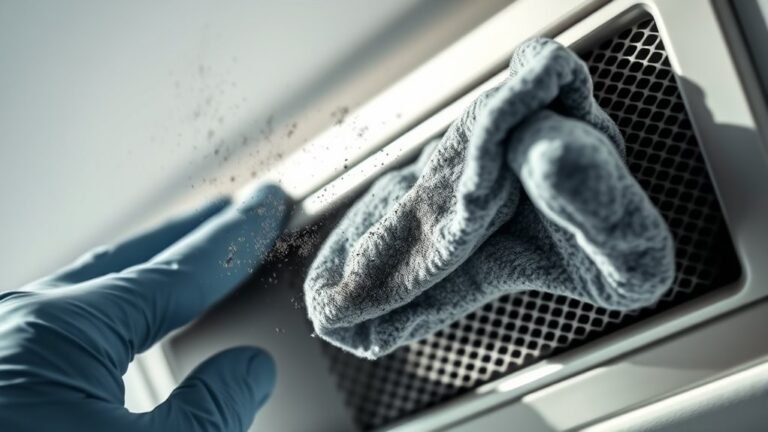How to Clean and Maintain Your Ceiling Fan
To clean and maintain your ceiling fan, first turn it off and guarantee the blades are still. Use a stable ladder and microfiber cloth to gently remove dust, avoiding harsh chemicals. Wipe blades with a damp cloth for dirt, and use lightweight oil on moving parts to keep things running smoothly. Tighten any loose screws to prevent wobbling. Regular maintenance helps your fan work efficiently and last longer. Keep going to uncover more useful tips for upkeep.
Tools and Materials Needed for Cleaning

Before you begin cleaning your ceiling fan, make certain you have the right tools and materials on hand. Fan maintenance is easier and more effective when you’re prepared. Gather essential cleaning supplies like a microfiber cloth, a step ladder for safe reach, and a gentle all-purpose cleaner or a mixture of water and mild soap. You’ll also want a vacuum with a brush attachment to remove dust from hard-to-reach spots. Avoid harsh chemicals that could damage the fan’s finish. Having these tools ready lets you tackle the job quickly and efficiently, giving you the freedom to enjoy a cleaner, fresher space without hassle. Proper cleaning supplies guarantee your ceiling fan runs smoothly and looks great, making maintenance a simple, rewarding task.
Preparing Your Ceiling Fan for Cleaning
Once you’ve gathered your supplies, make certain the fan is turned off and the blades have stopped moving completely. This step guarantees your safety and protects the fan’s motor during fan maintenance. Sticking to a regular cleaning schedule not only extends your fan’s life but also keeps your space fresh and dust-free. Before you start, place a drop cloth or old sheet beneath the fan to catch falling dust and debris.
| Step | Tip |
|---|---|
| Turn off the fan | Use the wall switch or remote |
| Wait for blades | Confirm blades are still |
| Cover the floor | Use a drop cloth or sheet |
| Check your ladder | Stable and secure |
Prepping right frees you to clean efficiently and enjoy your fan’s breeze without hassle.
How to Safely Remove Dust From Fan Blades

Although dust on fan blades might seem harmless, it can reduce airflow and spread allergens throughout your room. To keep your space fresh and breezy, mastering dust removal techniques is key. Start by turning off the fan and ensuring the blades are still. Use a microfiber cloth or a soft duster to gently wipe each blade, moving from the center outward to avoid pushing dust into the motor. For fan blade safety, avoid harsh scrubbing or using abrasive materials that could damage the surface. If you prefer, you can also use a pillowcase to trap dust by slipping it over each blade and wiping it clean. Taking these simple steps lets you maintain your fan’s efficiency and enjoy cleaner air without hassle.
Cleaning Fan Blades With a Damp Cloth
When you want to remove stubborn dirt or sticky residue from your fan blades, using a damp cloth can be very effective. Pay attention to your ceiling fan’s blade material—wood, metal, or plastic—to choose the right cleaning method without damage. Keep in mind that your cleaning frequency depends on how often you use the fan and the environment it’s in.
Here’s how to clean fan blades with a damp cloth:
- Use a soft, lint-free cloth slightly moistened with water or mild cleaner.
- Wipe each blade gently to avoid scratching or warping.
- Dry blades immediately with a dry cloth to prevent moisture damage.
- Avoid soaking blades, especially if made of wood or delicate materials.
This simple step keeps your fan fresh and running smoothly, giving you freedom from dust and grime buildup.
Dealing With Stubborn Dirt and Grime

If your ceiling fan has stubborn dirt or built-up grime, a regular damp cloth might not cut it. You’ll want to use effective cleaning solutions that break down tough residue without damaging the blades. Let’s explore the best methods to remove that stubborn buildup safely and efficiently.
Effective Cleaning Solutions
Tackling stubborn dirt and grime on your ceiling fan requires more than just a simple dusting. To enjoy a fresh and clean fan without harsh chemicals, lean into natural cleaning and homemade solutions. These options give you control and freedom over what touches your home environment.
Try these effective approaches:
- Mix equal parts water and white vinegar for a powerful, natural degreaser.
- Use a few drops of mild dish soap in warm water to break down dirt.
- Apply baking soda paste for gentle scrubbing on tough spots.
- Essential oils like lemon or tea tree add freshness and disinfect naturally.
With these simple, eco-friendly methods, you’ll keep your ceiling fan spotless and safe, all while embracing your freedom to choose what cleans your space.
Removing Built-Up Grime
Although regular dusting keeps your ceiling fan looking fresh, built-up grime requires a bit more effort to remove. When grime buildup gets tough, don’t settle for quick wipes. Grab a mild detergent mixed with warm water, and use a soft cloth or sponge to gently scrub each blade. This approach breaks down stubborn dirt without damaging the fan’s finish. Remember, adjusting your cleaning frequency can prevent grime from accumulating too much. If you notice persistent grime, it’s a sign to increase how often you clean. Taking control of grime buildup not only improves your fan’s appearance but also guarantees better air quality and efficiency. Stick to this routine, and your fan will stay free, clear, and ready to cool your space effortlessly.
Cleaning the Fan Motor and Housing
Before you start cleaning the fan motor and housing, make sure the fan is turned off and the power is disconnected. This step is essential for your safety and to protect the fan’s internal components. For effective housing maintenance, you’ll want to:
- Use a soft cloth or a microfiber duster to gently remove dust.
- Avoid spraying water or cleaning solutions directly onto the motor.
- Use a vacuum with a brush attachment to clear out any debris.
- Check for loose screws or signs of wear while cleaning.
Keeping the fan motor and housing clean not only extends your fan’s life but also keeps your space feeling fresh and unrestricted. Remember, regular maintenance lets you enjoy the freedom of a smoothly running ceiling fan without unexpected breakdowns.
Lubricating Moving Parts for Smooth Operation
To keep your ceiling fan running smoothly, you’ll need to choose the right lubricant designed for small motors. Applying it properly to the moving parts guarantees quieter operation and extends the fan’s lifespan. Let’s go over how to pick and use lubricant effectively.
Choosing the Right Lubricant
Why does choosing the right lubricant matter for your ceiling fan? Picking the best lubricant keeps your fan running smoothly without gumming up or wearing out prematurely. When choosing lubricant wisely, consider the different lubricant types available, as not all are suited for ceiling fans.
Here’s what you should keep in mind:
- Use lightweight oil designed for electric motors or fans
- Avoid heavy grease that can attract dust and cause buildup
- Choose a lubricant that won’t evaporate quickly, ensuring lasting protection
- Check for non-toxic, odorless options to keep your space fresh
Applying Lubricant Properly
Once you’ve selected the right lubricant for your ceiling fan, knowing how to apply it correctly will keep the moving parts running smoothly and quietly. Different lubricant types, like silicone spray or light machine oil, suit various fan models, so always check your fan’s manual. Start by turning off the power and removing the fan blades to access the motor and bearings. Use a clean cloth to wipe any old grease or dust away. Then, apply a few drops of lubricant directly to the moving parts—avoid over-lubricating, which can attract dirt. Application techniques such as using a precision oiler or syringe help you target tight spaces without mess. Proper lubrication reduces friction and noise, giving you the freedom to enjoy your fan’s smooth, efficient operation for years.
Checking and Tightening Fan Components
Although your ceiling fan may seem steady, it’s important to regularly check and tighten its components to keep it running smoothly and safely. Loose screws and bolts can cause fan wobbling or noise issues, disrupting your comfort and freedom. Take a few minutes to:
Regularly tightening your ceiling fan’s components prevents wobbling and noise, ensuring smooth and safe operation.
- Inspect blade brackets and tighten any loose screws
- Check the downrod and motor housing for secure fittings
- Verify blade balancing clips or weights are properly attached
- Tighten the canopy screws holding the fan to the ceiling
Scheduling Regular Maintenance for Longevity
To keep your ceiling fan running efficiently for years, you’ll need to schedule regular maintenance sessions. Creating a maintenance schedule guarantees you never forget essential tasks like regular cleaning and checking for loose parts. Aim to clean your fan blades every few months to prevent dust buildup, which can slow down the motor and reduce airflow. Alongside cleaning, inspect the fan’s components to catch any issues early. Setting reminders on your phone or calendar makes staying consistent effortless, freeing you from last-minute fixes or replacements. By sticking to a simple maintenance schedule, you’re not just preserving your fan’s performance—you’re also saving time and money. This way, your ceiling fan stays reliable, letting you enjoy cool comfort without hassle or interruption.
Frequently Asked Questions
Can Ceiling Fans Be Cleaned While Running?
You might think cleaning a ceiling fan while it’s running saves time, but it’s not safe or effective. Fan maintenance requires careful cleaning techniques to avoid injury or damage. You want freedom to enjoy your space, so always turn the fan off before dusting or wiping blades. This way, you prevent accidents and guarantee a thorough clean. Taking these simple precautions keeps your fan running smoothly and your home dust-free.
Is It Safe to Use Chemical Cleaners on Fan Blades?
You might wonder if chemical cleaners are safe for your fan blades. The truth is, it depends on the fan blade materials—some finishes react poorly to harsh chemicals, leaving behind residue that can damage or discolor them. To keep your freedom to clean without worry, opt for gentle, non-abrasive cleaners or natural solutions. This way, you avoid chemical residue buildup and extend your fan’s life without restricting your cleaning choices.
How Often Should Ceiling Fan Bulbs Be Replaced?
You should replace your ceiling fan bulbs based on their bulb lifespan, which varies by type—LEDs can last up to 25,000 hours, while incandescent bulbs need changing more often. Keeping energy efficiency in mind, choosing long-lasting LED bulbs saves you time and money, letting you enjoy your fan’s comfort without frequent replacements. So, swap bulbs only when they burn out, freeing you from unnecessary hassle and expenses.
Can Ceiling Fans Help Reduce Energy Costs?
You bet ceiling fans can help reduce energy costs! By improving air circulation, they boost energy efficiency, allowing you to rely less on heating or cooling systems. This means you enjoy cost savings on your utility bills without sacrificing comfort. Plus, fans give you the freedom to keep your space fresh and breezy, making them a smart, energy-wise choice for any home looking to save money and stay comfortable year-round.
Are There Special Ceiling Fans for Humid Environments?
You might think any ceiling fan can handle humidity, but that’s not true. If you want your fan to last in damp conditions, you’ll need humidity resistant models designed specifically for that challenge. Outdoor fans are perfect for you if you crave freedom from worrying about moisture damage. They’re built with special materials to resist rust and corrosion, giving you peace of mind while enjoying fresh air no matter how humid it gets.






